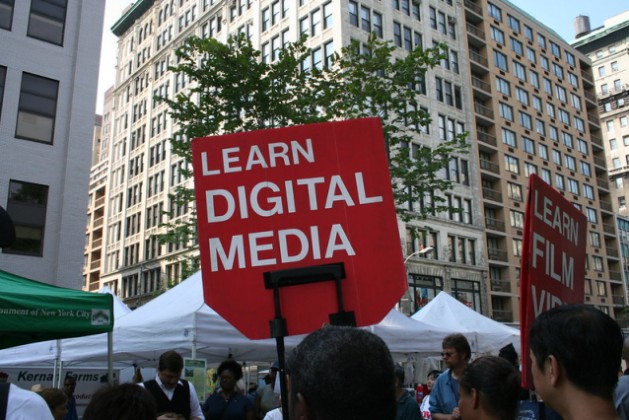
Photo (cc) 2006 by MyEyeSees.
Previously published at WGBHNews.org.
The Boston Globe now has more than 200,000 digital subscribers, editor Brian McGrory said at a Zoom gathering of the Society of Professional Journalists’ New England chapter earlier this week.
Much of the recent growth, he said, has been driven by interest in the Globe’s coverage of the COVID-19 pandemic. In a follow-up email, McGrory told me that the number of digital-only subscribers has risen from about 145,000 just before the pandemic to nearly 205,000 today.
“It took us 7 years to get our first 100,000 digital-only subscribers, and about 11 months to get to 200,000,” he said, adding: “The rise has been substantial, gratifying, and important in terms of supporting our journalism…. We’re the only metro paper that could support the current size of its newsroom through revenue from digital subscribers.”
That 200,000 mark has been a goal for a long time. When I interviewed McGrory in early 2016 for my book “The Return of the Moguls,” he told me, “If we got to 100,000 things would be feeling an awful lot better. And if we got to 200,000, I think we’d be well on our way to establishing a truly sustainable future.”
This week’s landmark comes with some caveats, though.
First, most of those new subscriptions were sold at a steep discount, generally in the range of $1 a month for the first six months. Given that the Globe’s profitability (pre-COVID, anyway) was built on an industry-high rate of $30 a month, the paper will presumably face a challenge in keeping those new subscribers.
Second, although we’ve been heading into the post-advertising era for quite a while, the pandemic has sent ad revenues across the newspaper business into a steep downward plunge. As the newspaper analyst Ken Doctor wrote for Nieman Lab in late March, “Advertising, which has been doing a slow disappearing act since 2008, has been cut in half in the space of two weeks. It’s unlikely to come back quickly — the parts that do come back at all.”
Nor has the Globe been immune from budget cuts. Co-op students, summer internships and freelance were cut right at the start of the shutdown. Don Seiffert recently reported in the Boston Business Journal that there have been an unspecified number of layoffs in advertising and other non-news operations, as well as reduced retirement contributions, in response to “significant” reductions in revenue.
Still, that’s minimal compared to what’s taking place across the newspaper business. The New York Times reported several weeks ago that some 36,000 news employees throughout the United States have been laid off, furloughed or had their pay cut. Many papers have cut back on the number of print days or eliminated print altogether. Some are closing. Poynter Online is keeping a list of cuts, and it is long and daunting.
The three leading national papers — The New York Times, The Washington Post and The Wall Street Journal — have been exceptions to the death-of-newspapers narrative for several years. But among the big regional papers, the Globe is doing better than all but a handful. In late 2018, publisher John Henry said the paper had achieved profitability. A year ago, Joshua Benton reported in Nieman Lab that the Globe had become the first U.S. regional paper to sign up more digital subscribers than weekday print subscribers.
But print still accounts for a lot of revenue in the newspaper business. Last week the Times reported that its shrinking print edition still accounted for more than half of its revenues. The Globe charges about $1,300 for seven-day print delivery. That’s a lot of money, but its print subscriber base continues to shrink. According to the Globe’s most recent filing with the Alliance for Audited Media, weekday print circulation is under 85,000 and Sunday print is about 147,000.
During the SPJ session, McGrory was asked why the Globe has kept COVID-19 coverage behind a paywall given that some other news organizations have made it free. McGrory responded that pandemic coverage is already free at two other Globe-owned sites: Stat News, which covers health and life sciences, and Boston.com. He added that he didn’t see cost as an obstacle in light of the discounts.
Via email, I asked McGrory about what steps the Globe was taking to keep all of its new subscribers once they were asked to pay $30 a month. “We’ve significantly ratcheted up the rate at which we’re graduating people from the low introductory rate into the full rate,” he replied. “We were doing really well with that retention before the coronavirus hit, and far better since.”
He added: “To keep the new subscribers who are part of this surge, we’re doing a lot of outreach — letters from notable staff members and the like. We’re also doing gifts, a possible loyalty program, virtual events for new subscribers…. There’s more. These readers are so vital to our future, and we want to let them know that. Of course, the most important thing is to feed them consistently strong and relentlessly interesting journalism. We will be in a huge news cycle for many, many months, between the virus and the massive economic disruption that it’s caused, inequality laid devastatingly bare, an epic presidential race, a reordering of so many things core to so many of our lives, condensed sports seasons, and on and on.”
Talk about this post on Facebook.






